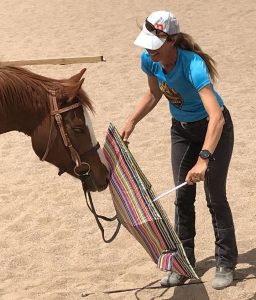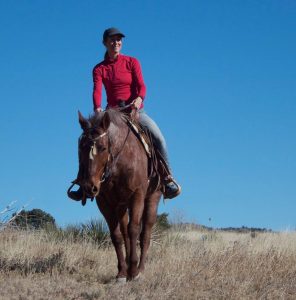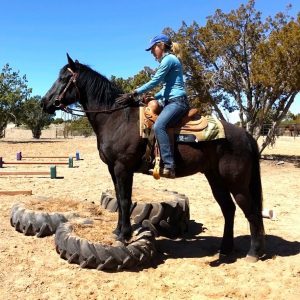Editor’s Note: Best Horse Practices Summit presenter Katrin Silva grew up riding dressage in Germany before moving to the United States at age 19 to learn to ride Western. She’s been riding both disciplines for the last 20 years and is a regular guest columnist for Cayuse Communications. The author of Dressage for All of Us: How to Help Any Horse Become a Happier, More Responsive Riding Partner lives in New Mexico where she works with dressage and Western clients. Visit her blog here.
 Katrin writes:
Katrin writes:
When I was younger, I thought the more I practiced what I wanted my horses to learn, the better they would go. I believed more repetitions would automatically lead to improvement because, as we’ve all heard, practice makes perfect. I wanted to be a good trainer, so I practiced. A lot. But over the years, my mindset has shifted from “practicing” skills and movements to playing with them. It’s a distinction that has made a big difference.
I still believe in practice. Without it, our horses will not become balanced athletes or willing partners. We need to spend enough time stretching the horse’s back, gymnasticizing both of his sides equally, developing his top line, and building his confidence. None of this happens overnight. There is a truth to the saying that a good horse comes from lots of wet saddle blankets.
But when we hear the word, “practice”, many of us understand this as practicing a movement or pattern over and over until we’re satisfied. “Practice” goes hand in hand with the saying “No pain, no gain!” or a phrase I heard a lot in Germany as a child: “First, you work. When you’re done, you can have fun.”
 The underlying belief is that joy gets in the way of progress. That, if you’re having a good time, it does not count as practice. But if we are trying to grind out 50 trot lengthenings because we’re not satisfied and, dammit, we’re not going to quit until we’re satisfied, then we’re not only being unfair to the horse. We’re depriving ourselves of joy and partnership. We’re standing in the way of true learning.
The underlying belief is that joy gets in the way of progress. That, if you’re having a good time, it does not count as practice. But if we are trying to grind out 50 trot lengthenings because we’re not satisfied and, dammit, we’re not going to quit until we’re satisfied, then we’re not only being unfair to the horse. We’re depriving ourselves of joy and partnership. We’re standing in the way of true learning.
I think we all need to play more. Play with advanced movements. Play with new skills. Play with trail obstacles.
What is play? And can we make progress if we don’t engage in serious practice?
Social scientist Dr. Peter Gray defines five elements of play. Here’s how they apply to connecting with horses:
- “Play is self-chosen and self-directed.”
Play is anything that no one makes us do. For most of us, this is true for riding horses, in general. But sometimes, when we put pressure on ourselves, riding can feel like an obligation. I’ve been there, in a cycle of too much work and not enough joy. Lately, I’m reminding myself every day that riding is something I choose to do, not something I have to do.
- “Play is intrinsically motivated.”
When we play, process is more important than the outcome. Riding itself matters more than the goals we set for ourselves and our horses.
 Of course, play can have goals, like winning a class at a show. But the goal is not what keeps us in the game. I used to get discouraged at shows because I defined my worth by how I placed. Now, I remind myself that I’d still ride horses all day, every day, even if I placed last. I want to ride the best I can, but I do this for its own sake and the horse’s sake. When the goal means than the journey, training horses is no longer truly play
Of course, play can have goals, like winning a class at a show. But the goal is not what keeps us in the game. I used to get discouraged at shows because I defined my worth by how I placed. Now, I remind myself that I’d still ride horses all day, every day, even if I placed last. I want to ride the best I can, but I do this for its own sake and the horse’s sake. When the goal means than the journey, training horses is no longer truly play
- “Play is guided by rules, but the rules leave room for creativity.”
From video games to team sports to children building mud pies, even if things look random, all play has rules. The crucial point is that these rules are flexible enough to allow creative reinterpretation.
This is true for good horsemanship: we want to follow what time and experience have proven to work, but we can adjust because each horse is an individual and situations evolve.
- The training scale is not set in stone.
- Our favorite clinician is not infallible.
Rules provides guidance, but they don’t dictate everything we do every minute we spend with our horses. Good horsemanship means we know the rules, but we can bend them if needed.
- “Play is imaginative.”

Katrin Silva at work in New Mexico
Imagination is key to keeping our horse time enjoyable. When I was a child, my friends and I spent lots of time goofing around on our ponies, pretending we were medieval knights or outlaws on the run. This may not have made us expert riders, but it kept us laughing and wanting to spend tons of time on horseback. Now, I try to help my students learn by conjuring up mental images:
- A horse’s free walk should feel like a big cat strutting through a forest.
- Soft contact should feel like a pleasant handshake with a celebrity you’ve been dying to meet.
This works much better than barking “Heels down!”
I also try to use my imagination in competitive situations, like dressage shows. The random letters and white breeches are part of a pretend world we choose to play in for a weekend.
- “Play is conducted in an active, alert, but relatively stress-free frame of mind.”
This is the most important feature of play; it puts us in a flow state. It absorbs us.
It feels focused and relaxed at once. It’s not a conscious effort to get things right. It’s a frame of mind where mistakes are no big deal, where backtracking is perfectly fine. We laugh off the bad transition or bungled flying change and we try again. Or maybe don’t try again until later.
Let’s all play more. It may seem counterintuitive, but I find my horses and I learn better that way.
What a great article!! When I re-discovered imagination in my horsemanship, it led to so much more play in my training and was the solution to getting bored with routine. It reinvigorated my horsemanship journey!
Thank you, Jenny! Yes, boredom is the enemy of good horsemanship. I tend to get stuck in repetitive patterns, especially when getting ready for a dressage show. It’s so tempting to ride the movements of the test, exactly the way they appear in the test. I have to remind myself all the time that I can change things up. There are a gazillion ways to ride the lateral movements or flying changes, both inside and outside the arena. We have to literally think outside the sandbox sometimes.